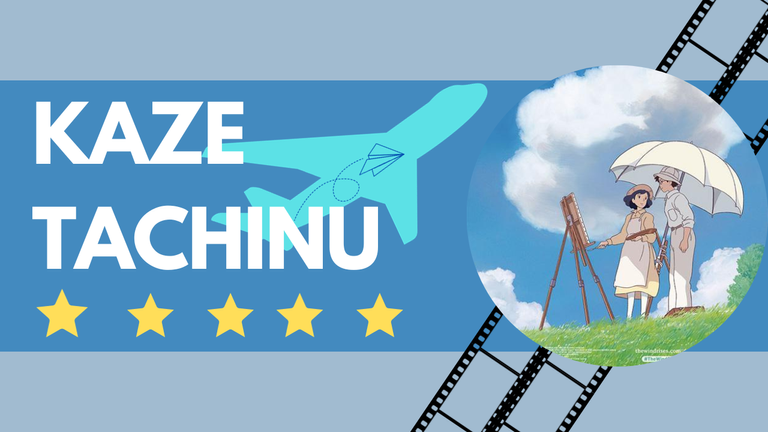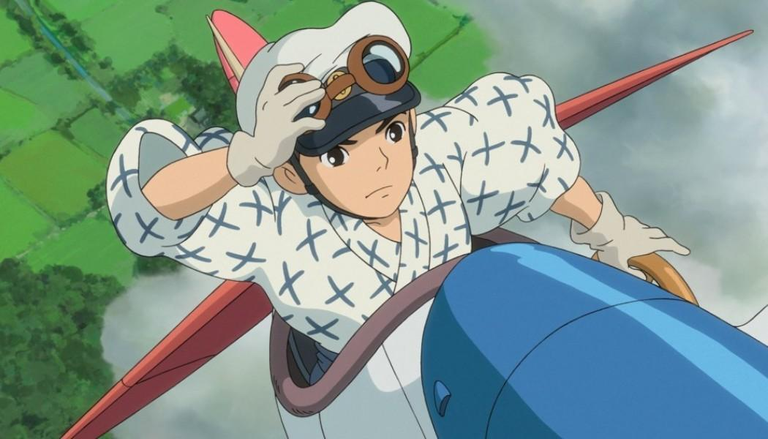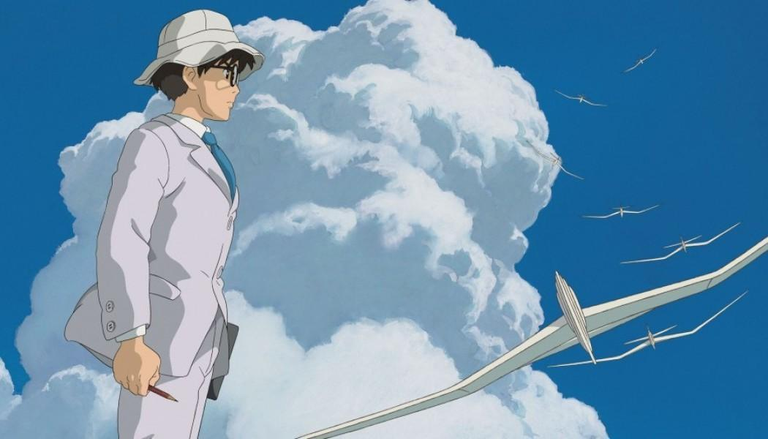Kaze Tachinu: un sueño con alas de metal – Opinión [ESP-ENG]

Canvas - Filmaffinity
Aviones y sueños de ingeniero se levantan al viento en la obra de Hayao Miyazaki y los estudios Ghibli. En alegorías bélicas nos adentramos en la ruralidad de un Japón que desea conquistar los cielos con alas de metal. Jirō Horikoshi cobra un relevante protagonismo en las aspiraciones de una nación que decide involucrarse en la guerra, aunque él solo desea crear máquinas voladoras para la diversión con un ingeniero italiano que lo visita en los sueños.
“Sueños” “Vida…”
Kaze Tachinu es la otra parte de la guerra: esa en donde no quieres participar, pero tus sueños te obligan.
Airplanes and engineering dreams soar in the wind in the work of Hayao Miyazaki and Ghibli Studios. In warlike allegories, we enter the rurality of a Japan that wishes to conquer the skies with metal wings. Jirō Horikoshi takes a relevant role in the aspirations of a nation that decides to get involved in the war, although he only wishes to create flying machines for fun with an Italian engineer who visits him in dreams.
"Dreams" "Life..."
Kaze Tachinu is the other side of war: the one where you don't want to participate, but your dreams force you.

Filmaffinity
Vale entender que Miyazaki es un genio para diezmar a la retórica de las películas bélicas nacionalistas: nada de sangre y honor bajo el argumento de una sola cara de la moneda. Nadie quiere ser el malo de la historia, y mucho menos si fue parte del bando vencedor. La verdad es que no hay ganadores en las guerras, de lo contrario, aquella fatídica ocasión de nazis y aliados jamás hubiera terminado con tantos muertos. El largometraje de Miyazaki no va a mostrarte lo que otros ya te han mostrado: no es necesario ser tan crudo para conocer que algo es siniestro.
En Kaze Tachinu (nombre japonés del Film) verás la historia de un jovencito con sueños de aviación, al cual le preocupa que su enfermedad visual arruine sus sueños de aeronáutica. “¡Los cegatos no pueden volar aviones!”, dice con inocencia, hasta que un inesperado amigo, que resulta ser también su mayor inspiración, le revela la verdad: los ingenieros solo necesitan la mente para volar. Jirō, o el chico japonés, se aventura entonces en una carrera para alcanzar las nubes, aunque no como lo imaginó al principio.
It is worth understanding that Miyazaki is a genius at decimating the rhetoric of nationalistic war films: no blood and honor under the argument of only one side of the coin. No one wants to be the bad guy in the story, much less if they were part of the winning side. The truth is that there are no winners in wars, otherwise, that fateful occasion of Nazis and Allies would never have ended with so many dead. Miyazaki's feature film is not going to show you what others have already shown you: it is not necessary to be so crude to know that something is sinister.
In Kaze Tachinu (the Japanese name for the Film) you will see the story of a young boy with dreams of aviation, who worries that his visual disease will ruin his dreams of aeronautics. "Blind people can't fly planes!" he says innocently, until an unexpected friend, who also happens to be his greatest inspiration, reveals the truth to him: engineers only need their minds to fly. Jirō, or the Japanese boy, then ventures into a race to reach the clouds, though not as he first imagined.

Filmaffinity
Jirō Horikoshi existió de verdad, de hecho, al final del film se revela un homenaje al diseñador de un modelo de avión que desató la respuesta nuclear. La segunda guerra mundial fue una batalla de intelectos, eso sí, también de moralidades. Repasamos el mundo interno de un amante a los aviones, por naturaleza, por arte y por el amor a superar sus propias capacidades. En la fantasía de sus sueños, presenciamos el cielo eterno donde los modelos aeronáuticos vuelan infinitos… algunos dibujados con muertos, otros con la belleza de llevar al hombre a acariciar las alturas.
El pincel de Hayao Miyazaki esboza belleza en la mente de un protagonista que, además de ser un genio para los aviones, también tiene un corazón capaz de enamorarse. He aquí el segundo eje de un biopic con toques alucinantes y humanos, sin caer en los dilemas bélicos de los bandos opuestos. El propio largometraje afirma el destino de un Japón agonizante, con señales sutiles de un desastre con proporciones inimaginables. No es algo que haya que mostrar con bombas, tanques o metralletas… Kaze Tachinu es una obra de la belleza creativa, el amor y el intelecto.
Jirō Horikoshi existed, in fact, at the end of the film a tribute to the designer of a model airplane that triggered the nuclear response is revealed. World War II was a battle of intellects, yes, also of moralities. We review the inner world of an airplane lover, by nature, by art, and by the love of surpassing his capabilities. In the fantasy of his dreams, we witness the eternal sky where aeronautical models fly infinitely... some drawn with dead people, others with the beauty of taking the man to caress the heights.
Hayao Miyazaki's brush sketches beauty in the mind of a protagonist who, besides being a genius for airplanes, also has a heart capable of falling in love. This is the second axis of a biopic with hallucinatory and human touches, without falling into the warlike dilemmas of the opposing sides. The film itself affirms the fate of a dying Japan, with subtle signs of a disaster of unimaginable proportions. It is not something to be shown with bombs, tanks, or machine guns... Kaze Tachinu is a work of creative beauty, love, and intellect.

Filmaffinity
Kaze Tachinu es una animación que corre en dirección contraria a los largometrajes animados de occidente; al verla pasearás por el milagro de la aviación y la antítesis creativa. Una rosa no es destructiva hasta que sus pétalos son envenenados. Me pregunto si los hermanos Wright pensaron alguna vez que su hazaña iba a ser replicada muchos años después, en el cataclismo bélico que terminó por reconfigurar las potencias mundiales y los rostros de la aviación. No me sorprende que este film, inspirado en los hechos reales, tuviera esa sutil crítica a la guerra con toques tan pintorescos. Sin duda, es otra de las grandes obras de Miyazaki.
Al final, el mensaje irradia la proeza del viento que se levanta y eleva sueños, sueños altos y peligrosos. La metáfora de la rosa envenenada se convierte entonces en un referente perfecto para lo que desea transmitir este film. Los aviones no son para la guerra, ni nada en absoluto. Entre tantos males, solo queda la esperanza de seguir viviendo, con sueños altos como un avión en el cielo… sin miedo a ser derrumbados, solo marcando la dirección constante hacia el horizonte.
Vivir, junto al viento, con sueños semejantes a las alas de metal.
Kaze Tachinu is an animation that runs in the opposite direction of Western animated feature films; watching it you will walk through the miracle of aviation and creative antithesis. A rose is not destructive until its petals are poisoned. I wonder if the Wright brothers ever thought that their feat would be replicated many years later, in the cataclysmic war that ended up reshaping world powers and the faces of aviation. I am not surprised that this film, inspired by real events, had such a subtle critique of war with such picturesque touches. It is undoubtedly another of Miyazaki's great works.
The message radiates the prowess of the wind that rises and lifts high and dangerous dreams. The metaphor of the poisoned rose then becomes a perfect reference for what this film wishes to convey. Airplanes are not for war, or anything at all. Among so many evils, there is only the hope of continuing to live, with dreams as high as an airplane in the sky... without fear of being knocked down, only marking the constant direction towards the horizon.
To live, along with the wind, with dreams like metal wings.
Congratulations @soldierofdreams! You have completed the following achievement on the Hive blockchain And have been rewarded with New badge(s)
Your next target is to reach 450 posts.
You can view your badges on your board and compare yourself to others in the Ranking
If you no longer want to receive notifications, reply to this comment with the word
STOPTo support your work, I also upvoted your post!
Check out our last posts:
Amo esta película, sin duda es una de las mejores de Miyazaki (aunque digo eso de todas sus películas, jajajaja). Me encanta como su mensaje antibélico siempre está presente, así sea en una historia romántica o en la de un soñador. Lamentablemente, "El viento se levanta" no es tan conocida, a pesar de ser una verdadera obra de arte.
Ahhh, me olvidaba de la música, creo que tiene mi composición favorita de Joe Hisaishi para Ghibli, es una espectacularidad. Te la dejo porque es imposible para mí no escucharla después de haberte leído:
Hablando meramente del soundtrack, debo admitir que me recordó a una mezcla de la vieja Italia, no sé si es una combinación que tenga que ver con el galeron y el tango, XD... pero me fascina. Esta es una obra maravillosa del maestro Miyazaki, ¡vaya que este señor sabe como mover las nostalgias! Creo que hace poco se estrenó "El Niño y La Garza", es su peli más reciente. También promete y mucho, XD. ¡Gracias por leer y comentar! Saludos cordiales, mi estimada.
Así es, a mi también me suena un poco a música italiana, imagino que como referencia al héroe de Jiro.
Siii, la película nueva se estrenó hace creo que un mes en Japón, pero por lo menos en México aun no tiene fecha definitiva de estreno, así que a esperar😞
Si, toca esperar 😢, XD. Pero de seguro ha de estar muy buena 🔥. La espera valdrá la pena jejejeje. Saludos.